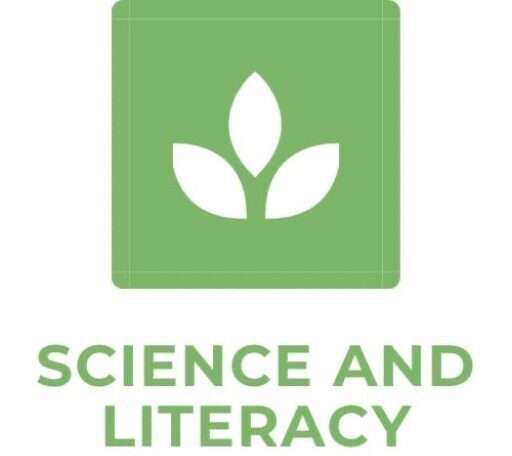In the ever-evolving landscape of education, digital tools are rapidly becoming integral to modern teaching. SCORM courses, birthed from the collaborative efforts of the eLearning community in the early 2000s, have paved the way for consistent and standardized digital learning experiences. The initiative, led by the Advanced Distributed Learning (ADL) Initiative, was set into motion to address the compatibility issues between eLearning content and various platforms. Today, ADL still oversees the SCORM standards, ensuring its relevance and adaptability to modern eLearning needs.
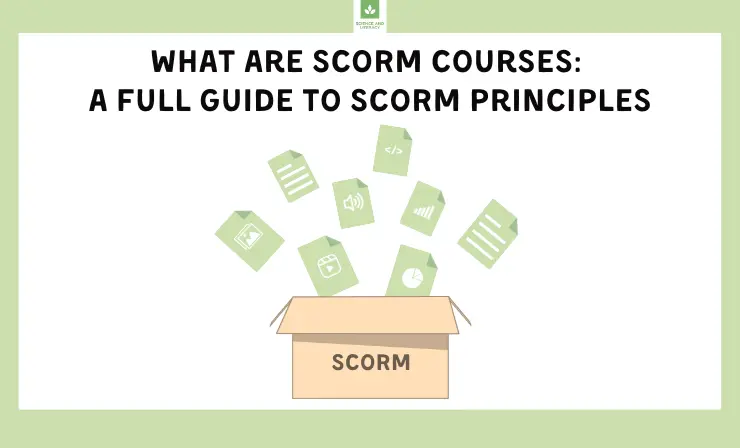
Rustici Software is a key figure in the SCORM world, known for simplifying SCORM implementation with its tools and products. The company has been pivotal in enabling seamless eLearning content integration across platforms, making SCORM more streamlined and accessible for both organizations and educators.
Among these digital tools, SCORM courses stand out as a transformative asset, especially relevant for school teachers navigating the blend of traditional and eLearning environments. SCORM, an acronym for Sharable Content Object Reference Model, represents a set of technical standards ensuring that eLearning content is universally compatible and can seamlessly function across various Learning Management Systems (LMS). For teachers, this means a world of possibilities: imagine creating a digital lesson once and having the assurance it will work smoothly across different platforms, facilitating consistent learning experiences for all students.
Furthermore, SCORM’s tracking capabilities offer insights into each student’s progress, adapting the learning journey to individual needs. As education increasingly shifts towards a blended model, understanding SCORM can empower teachers to leverage the best of both worlds, merging traditional pedagogies with the efficiencies of digital tools.
Dive into this article to unravel the intricacies of SCORM courses, their potential in revolutionizing classroom teaching, and practical tips on integrating them into your curriculum. Whether you’re a tech-savvy educator or just beginning your digital teaching journey, this guide aims to equip you with the knowledge to harness the full potential of SCORM in your classroom.
In this article you’ll learn about:
- What Is SCORM? →
- What is a SCORM Course? →
- Utilizing SCORM in School Education →
- 6 Tips for Creating SCORM Courses →
- The Future of SCORM: Evolving in the E-Learning Landscape →
- FAQ →
What Is SCORM?
SCORM, an acronym for “Shareable Content Object Reference Model,” represents an internationally recognized standard for electronic courses. In essence, when you design or select a lesson in SCORM format, you’re ensuring that nearly every Learning Management System (LMS) – the platforms where students access digital lessons – can display and interact with it correctly.
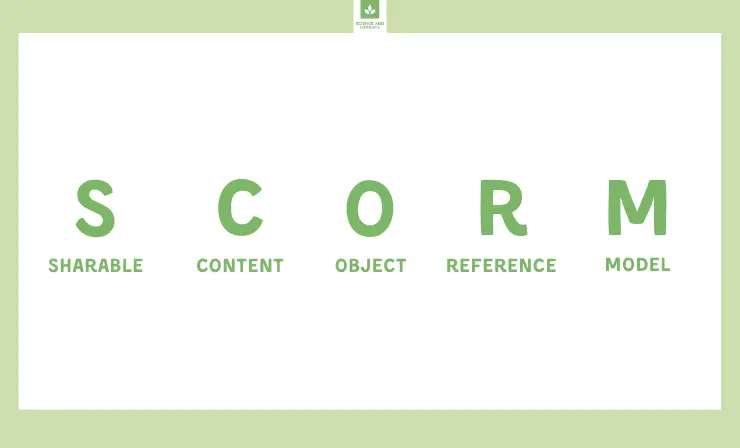
At its heart, SCORM is a comprehensive checklist of technical requirements. It provides educators with a blueprint on constructing a digital course that’s compatible across various platforms. It meticulously outlines how an e-course should be structured and details how it should communicate with different LMSs.
Imagine you’ve crafted a brilliant digital lesson on fractions, complete with interactive exercises, videos, and quizzes. You want to share it with your students through the school’s LMS, but then you discover the content isn’t displaying correctly or the quiz scores aren’t being recorded. This is where SCORM comes in. By creating or choosing content that adheres to SCORM standards, you ensure a smoother, more consistent experience for your students, regardless of the LMS you’re using. It’s like ensuring a DVD (remember those?) plays correctly in any DVD player.
How SCORM Works
SCORM consists of three distinct components:
- Content Packaging: This involves bundling all learning resources for a course into a single SCORM package. This package contains essential details required by the LMS for content import and launch. Essentially, it provides answers to queries like, “Which file should initiate first?” and “What’s the title of this module?”
- Run-time Communication: This element manages the data interaction between the LMS and the content, focusing on delivery and monitoring. The process starts with the content identifying the LMS. Following this, they interact using specific commands and a shared language. For clarity, it’s like commands that say, “Retrieve the student’s name” or “Notify the LMS that the student achieved an 80% score on this test.”
- Sequencing: This pertains to the learner’s progression through the course. It guides actions such as what occurs when a user clicks the ‘next’ button and determines the sequence of activities, ensuring certain sections are completed before advancing.
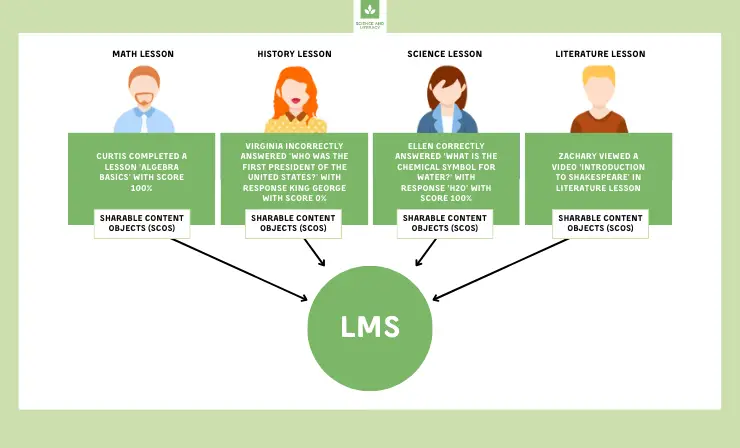
Benefits of the SCORM Format
Now that you’re familiar with SCORM and its functionality, let’s delve into the advantages it offers. You might be surprised by the numerous benefits it brings to the table:
- Compatibility: One of the standout features of SCORM is its wide-ranging compatibility. If you’ve developed or chosen a SCORM course, rest assured that nearly any Learning Management System (LMS) will recognize and display it correctly.
- Seamless Progress Saving: With SCORM, students have the flexibility to approach courses at their own pace. They can work through a module, take a break, and then pick up right where they left off. This continuity is maintained even if there’s a system glitch or an unintended course closure.
- Structured Learning Path: SCORM allows educators to design courses with a clear and logical structure. You can set specific pathways, such as requiring students to read a lecture before proceeding to an associated video, ensuring a systematic learning journey.
- Informative Feedback: SCORM courses empower educators with valuable insights into student progress. For instance, once a student finishes a module, you can instantly view their performance metrics, such as scores, or receive notifications like “Course Completed.”
- Enhanced Engagement: By incorporating multimedia elements, interactive scenarios, and adaptive learning paths, SCORM courses can engage students more deeply. This dynamic learning environment can cater to various learning styles, making lessons more impactful and memorable.
- Modularity: SCORM emphasizes modular design. This means that each segment of your course, whether a lecture, quiz, or video, is a distinct module. These modules can be easily reused or integrated into other courses, making content creation more efficient.
SCORM Versions: 1.2 and 2004
SCORM has evolved through various versions, each bringing its unique set of technical features to enhance the eLearning experience. Of the three primary versions – SCORM 1.1, 1.2, and 2004 – SCORM 1.1 isn’t extensively adopted and can be overlooked for our discussion.
Here’s a quick comparison of the two SCORM versions:
| Features | SCORM 1.2 | SCORM 2004 |
| Easy to implement | + | -/+ |
| Content Sequencing | – | + |
| Separate statuses for completion and success | – | + |
| Restricted access to select units | – | + |
| Read/write interactions | – | + |
| Universal compatability | + | -/+ |
SCORM 1.2, as depicted in the comparative chart, is widely recognized for its ease of implementation and universal compatibility. It primarily focuses on tracking a student’s progress within a course, for instance, reporting that “The learner has completed 70% of the course.” Once the course is entirely finished, a “Completed” status becomes evident in the system, providing a straightforward way to monitor engagement.
In contrast, SCORM 2004, while potentially presenting challenges in terms of universal compatibility, delves deeper into analytics. It stands out for its versatility, emphasizing content sequencing, separate statuses for completion and success, restricted unit access, and read/write interactions. Beyond merely indicating progress, SCORM 2004 offers valuable insights into a learner’s performance, detailing scores achieved both upon course completion and post-assessments. This granular approach furnishes educators with a comprehensive view of a student’s grasp on the content and their overall interaction within the learning environment.
For educators venturing into digital course creation, if you’re using an LMS that’s SCORM-compliant, a crucial first step is determining which SCORM version your LMS supports. This ensures seamless integration and optimal functionality of your e-course, leading to enriched learning outcomes for students.
Utilizing SCORM in School Education
School teachers can leverage SCORM in various ways to enhance their teaching and make the learning experience more interactive, consistent, and trackable for their students. Here’s how:
| Ways | Details |
| 1. Blended Learning | Incorporating SCORM modules can revolutionize traditional classroom settings, bridging the gap between in-person and digital learning. By using SCORM as part of their teaching strategy, educators can create a more fluid classroom environment. Homework doesn’t have to be just about written assignments. By assigning SCORM modules, students can immerse themselves in rich multimedia content, enhancing their comprehension and retention. |
| 2. Standardized Content Delivery | In schools where there are multiple educators teaching the same subject or grade, ensuring consistency in content delivery can be a challenge. SCORM offers a solution by ensuring uniformity in the instructional materials provided to all students. Guest educators or substitute teachers can also benefit from these pre-packaged modules, ensuring no disruption in the learning journey of the students. |
| 3. Interactive Learning Modules | Modern learners often resonate better with interactive content than traditional textbooks. SCORM packages can be rich with multimedia elements, quizzes, simulations, and interactive scenarios that cater to diverse learning preferences. Such interactive modules can transform subjects that students might typically find challenging or dull into engaging and interactive experiences. |
| 4. Tracking and Assessment | One of SCORM’s standout features is its tracking capability. Through integrated LMS platforms, teachers can gain insights into individual student progress, time spent on modules, and areas where students might be struggling. The ability to have quiz scores and assessments auto-recorded streamlines the grading process, allowing teachers more time for one-on-one student interactions. |
| 5. Flexible Learning | Life is unpredictable. Students might miss school due to various reasons. With SCORM, they don’t have to miss out on learning. They can access the content anytime, anywhere. The resume or “bookmark” feature of SCORM ensures that students can break their study sessions as needed, and return without losing their place. |
| 6. Customizable Content for Special Education | Every student is unique, and some may require specialized instructional methods. SCORM’s adaptability means that content can be tailored to cater to individual student needs, ensuring inclusivity in education. |
| 7. The Flipped Classroom Model | SCORM can play a pivotal role in the flipped classroom approach. Instead of traditional lectures, educators can assign SCORM modules for home study. Classroom time can then be focused on collaborative projects, discussions, and hands-on learning. |
| 8. Facilitating Content Sharing | The beauty of SCORM’s standardized format is the ease of sharing. An innovative module created by one educator can be seamlessly shared with peers, fostering a collaborative teaching environment. |
By integrating SCORM into their teaching repertoire, educators can provide a dynamic, interactive, and adaptable learning experience, preparing students for the digital age.
What is a SCORM Course?
A SCORM course, also termed as a SCORM module or package, is essentially a ZIP file adhering to the SCORM standard guidelines. This file, known as the Package Interchange File (PIF), encompasses all pertinent data required to import educational content into an LMS.
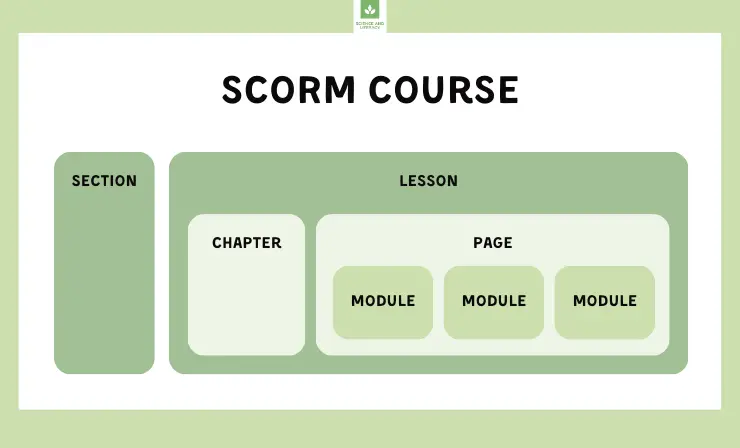
Contents of a SCORM Course
- XML Manifest File (imsmanifest.xml): This is the heart of the package. It furnishes detailed descriptions of the package and its enclosed content. Key elements within this file include a unique identifier, vital metadata that shed light on the package and its SCORM rendition, definitions of resources enumerating all requisite files for course execution, and a systematic organization of educational activities.
- Resource Files: These are the constituent components or “building blocks” of the course, facilitating the learning activities described within the package.
- Schema/Definition Files (XSD and DTD): These files are essential references for the manifest file, ensuring everything aligns with the SCORM standards.
How to Create a SCORM Course
In earlier days, crafting SCORM courses was a task reserved for professional programmers. Fast forward to today, and the landscape has dramatically shifted. With the advent of SCORM authoring tools, virtually anyone can design and package SCORM courses without a deep dive into coding.
Fast course authoring toolkit
Create online courses and assessments in record time.
Here are 3 of the most renowned authoring tools:
- iSpring Suite: A powerful tool by iSpring, Suitee is known for its advanced functionalities. It’s especially praised for its ability to create simulations, mobile-responsive courses, and software demonstrations. With a rich set of features, it caters to both beginners and seasoned developers.
- Articulate Storyline: Renowned for its user-friendly interface, Articulate Storyline allows creators to develop interactive courses with ease. It offers a range of templates, multimedia options, and responsive design features, making it a favorite among eLearning professionals.
- Lectora: Lectora stands out for its HTML5 publishing capabilities, ensuring courses are mobile-ready. It also boasts a unique set of editing tools and the ability to integrate with other eLearning tools, providing a holistic approach to course creation.
To discover a comprehensive list of the top 21 authoring tools, please refer to our informative article.
These tools, each with its unique set of features, have been instrumental in shaping the landscape of modern eLearning development.
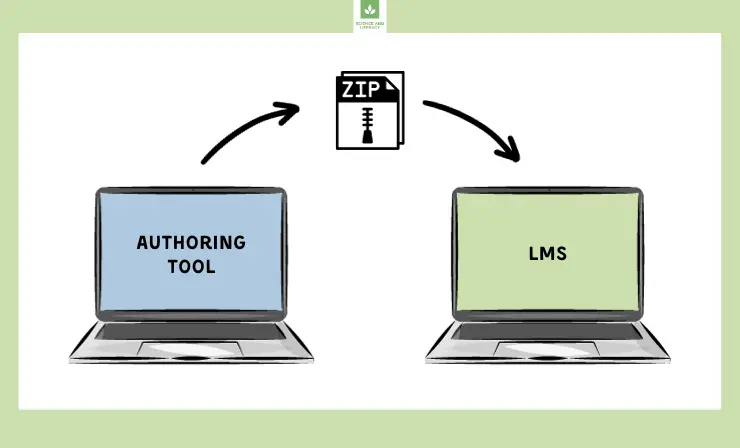
To create a SCORM package, start by selecting a SCORM-compliant authoring tool. Design your course by outlining content, adding multimedia, and integrating interactive components. Enable tracking mechanisms if monitoring is required. Before finalizing, preview and test the course for errors. Once satisfied, export the course as a SCORM package, ensuring compatibility with your LMS’s supported SCORM version. After uploading to the LMS, test the course’s functionality within that platform. If any issues arise or based on feedback, revise and re-export your course. Always maintain a backup of your original files for easy updates. Explore our article to learn about 5 methods for creating a SCORM-compliant course.
6 Tips for Creating SCORM Courses
Creating effective SCORM courses requires careful planning and an understanding of both instructional design and the technical aspects of the SCORM standard. Here are some tips to help ensure your SCORM courses are both engaging and effective:
1. Start with Clear Learning Objectives
Before diving into course creation, outline clear and measurable learning objectives. This will not only guide your content development but also ensure that assessments and interactive elements align with what you intend the learners to achieve.
2. Optimize Multimedia Use
Incorporate multimedia elements like videos, audio, and images judiciously. Ensure that they enhance understanding rather than distract. Keep file sizes manageable to ensure smooth loading and avoid overwhelming learners with too much information.
View this guide to master building stunning SCORM courses from the ground up:
3. Design for Interactivity
Interactive elements can boost engagement and understanding. Include quizzes, drag-and-drop exercises, and other interactive components that encourage active participation. Ensure these elements are SCORM-compliant so their results can be tracked in the Learning Management System (LMS).
4. Prioritize User Experience
Make sure the course is easy to navigate, with a clear structure, intuitive buttons, and straightforward progress indicators. Consider mobile responsiveness, as many learners might access the course via tablets or smartphones.
Check out this comprehensive tutorial for crafting well-organized SCORM courses:
5. Test Across Different LMS Platforms
While SCORM is designed for interoperability, there can still be variations in how different LMS platforms interpret and display SCORM content. It’s essential to test your course on multiple platforms to ensure consistent performance.
6. Keep Content Updated
One of the advantages of SCORM courses is the ease of updating content. Regularly review and refresh your course materials to ensure they remain relevant, accurate, and effective.
Remember, a successful SCORM course is not just about meeting technical specifications but also about delivering content in a way that’s engaging, accessible, and pedagogically sound.
The Future of SCORM: Evolving in the E-Learning Landscape
Since its inception, SCORM has been the gold standard for creating interoperable eLearning content, ensuring consistency across different Learning Management Systems (LMS). However, as technology evolves and learning methods diversify, how does SCORM fit into the future?
Firstly, while SCORM has provided a reliable framework for course content creation and tracking for years, newer standards like xAPI (Experience API) have begun to emerge. xAPI offers more granular tracking of learning experiences, not just within the confines of an LMS but across various platforms and real-world scenarios. As eLearning expands beyond traditional course modules into microlearning, gamified experiences, and even augmented reality, xAPI’s broader tracking capabilities could overshadow SCORM’s utility.
Additionally, the demand for mobile learning is growing exponentially. While SCORM courses can be made mobile-responsive, they aren’t inherently optimized for mobile platforms, unlike newer eLearning specifications. This shift demands a more flexible and adaptive standard than SCORM.
However, this doesn’t spell the end for SCORM. Given its widespread adoption, it’s likely to remain relevant, especially for institutions and organizations with legacy systems and a vast repository of SCORM-based content. Yet, as with all technologies, adaptation is vital. SCORM might see integrations with newer standards or evolve itself to meet contemporary needs.
While the eLearning landscape is shifting, SCORM’s foundational principles will continue to influence future standards and practices, even as newer specifications rise in prominence.
FAQ
Below, we’ve addressed some common queries related to SCORM.
What's the difference between SCORM and other eLearning standards?
While SCORM is a widely adopted eLearning standard, there are others like xAPI and AICC that offer different functionalities and tracking capabilities. Understanding their unique features can help educators choose the best fit for their needs.
Can SCORM courses be accessed offline?
Although SCORM courses primarily function online within an LMS, certain LMS platforms and newer standards might offer offline tracking which syncs data once reconnected.
Is SCORM only for schools?
No, while this article focuses on school applications, SCORM is used across industries, from corporate training to higher education and beyond.
Do I need coding skills to create SCORM content?
While early SCORM content required technical expertise, modern authoring tools have made it user-friendly. Basic courses require no coding, but advanced customization might benefit from technical knowledge.
How can I convert my existing non-SCORM content into SCORM-compliant courses?
Many authoring tools offer features to import and convert existing content, making it SCORM-compliant. However, the process might require some adjustments to ensure full compatibility.
Is SCORM suitable for all subjects and age groups?
Absolutely! SCORM is versatile, catering to varied subjects and age groups. The key lies in designing the content to match the audience's learning needs and preferences.
Can I update a SCORM course after it's been published?
Yes, most authoring tools allow you to edit and republish SCORM courses. Remember to inform learners and retest the course on the LMS after any updates.
Is SCORM compatible with mobile devices?
Yes, many modern SCORM courses are designed to be responsive, making them compatible with tablets and smartphones. However, the mobile experience may vary depending on the LMS and the design of the course itself.
Useful Resourses
Looking for a quick rundown? Check out this concise video for a swift overview of SCORM:
Conclusion
In the evolving eLearning landscape, SCORM stands as a testament to standardized, interactive content delivery. Its universal compatibility ensures that educational materials offer a consistent experience across platforms. As educators continue to harness digital tools, understanding and leveraging SCORM will remain pivotal in delivering efficient, trackable, and engaging learning experiences for students globally.
- 22 Essential Strategies to Check for Understanding: Enhancing Classroom Engagement and Learning - May 20, 2024
- 24 Innovative and Fun Periodic Table Project Ideas to Engage and Inspire Students in Chemistry Learning - May 9, 2024
- 28 Exciting Yarn Crafts for Preschool Kids: Igniting Creativity and Fine Motor Skills - April 29, 2024
